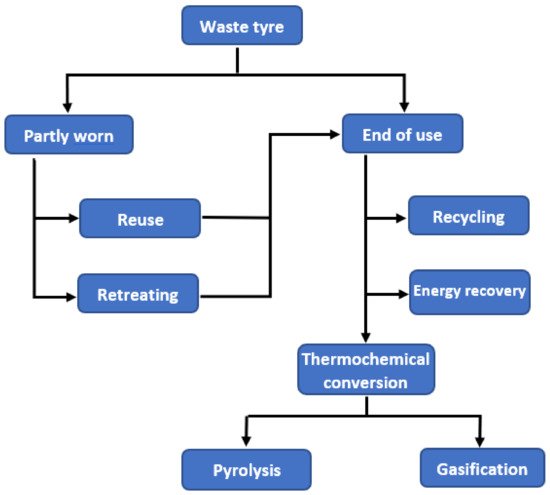Utilising pyrolysis as a waste tyre processing technology has various economic and social advantages, along with the fact that it is an effective conversion method. Despite extensive research and a notable likelihood of success, this technology has not yet seen implementation in industrial and commercial settings. In this review, over 100 recent publications are reviewed and summarised to give attention to the current state of global tyre waste management, pyrolysis technology, and plastic waste conversion into liquid fuel. The study also investigated the suitability of pyrolysis oil for use in diesel engines and provided the results on diesel engine performance and emission characteristics. Most studies show that discarded tyres can yield 40–60% liquid oil with a calorific value of more than 40 MJ/kg, indicating that they are appropriate for direct use as boiler and furnace fuel. It has a low cetane index, as well as high viscosity, density, and aromatic content. According to diesel engine performance and emission studies, the power output and combustion efficiency of tyre pyrolysis oil are equivalent to diesel fuel, but engine emissions (NOX, CO, CO, SOX, and HC) are significantly greater in most circumstances. These findings indicate that tyre pyrolysis oil is not suitable for direct use in commercial automobile engines, but it can be utilised as a fuel additive or combined with other fuels.
- waste tyre
- waste management
- pyrolysis
- automobile engine
1. Introduction
2. Waste Tyre Management Practice

3. Waste Tyre to Fuel Using Thermochemical Conversion
4. Waste Tyre to Oil, Carbon, and Steel
The recycling of waste tyres into useful products is of interest for both environmental and economic reasons. Many researchers have been working to solve the aforementioned issues and convert waste tyres into valuable products such as oil, carbon, and steel [50][51][52][69,92,93]. Waste-tyre oil could be used for heating by industry, refined further for use in diesel engines, or used directly as blended fuel in some stationary diesel engines. Carbon has a plethora of industrial uses, from toothpaste to electrodes and pharmaceutical goods, as well as being about 35% cleaner than coal and burning hotter, while steel can be sold as scrap metal or returned to tyre manufacturers for reuse.5. Diesel Engine Performance and Exhaust Emission Using Tyre Oil
6. Discussion and Synthesis
-
Conduct in-depth energy and economic studies of integrated waste tyre pyrolysis plants over their entire life cycle.
-
Recognise the trade-offs between the scale of the waste tyre pyrolysis plant and feedstock, as well as the costs of transportation to a centralised upgrading facility.
-
Development of the technology to overcome the limitations of the tyre pyrolysis reactor and process and improve the reliability.
-
Identify TPO criteria and quality standards for manufacturers and end-user.
-
Improve quality and consistency of TPO through the development of more effective technologies.
-
Develop catalyst for TPO upgrading in order to meet vehicle fuel-quality standards.
-
Develop deoxygenated catalysts to extract oxygen-containing compounds for pyrolysis processes for oil property improvement.
-
Advocacy to develop relevant policy, regulation, and financial incentives for the tyre recyclers, refineries and start-ups who take up the challenges of recycling used tyres to oil.
